AUDI A6 2015 Owners Manual
Manufacturer: AUDI, Model Year: 2015, Model line: A6, Model: AUDI A6 2015Pages: 314, PDF Size: 77.57 MB
Page 251 of 314

M N
0 <.J 'SI: ,...., \!) 1.1'1 ,...., 1.1'1 ,....,
affect the handling of the
vehicle.
- Incorrect tire pressures
and/or underinflation can
also lead to sudden tire fail ure, including a blowout
and sudden deflation, caus
ing loss of vehicle control.
Checking tire pressure
The correct tire pressure for the
tires originally installed on
your vehicle is listed on the tire pressure label located on driver's side 8-pillar .
The recommended tire pres
sures are on the tire pressure
label and in the table
c> page 244, Cold t ire inflation
pressure.
This means that the
pressure must be checked and
adjusted when the tire has not
been driven for more than a
couple of miles (kilometers) at
low speeds during the previous
three hours . Air in the tires ex
pands when the tire heats up as
a result of internal friction as it
flexes in use . The tire pressure
is higher when the tire has
warmed up than when it is "cold."
Tires and wheels 249
It is the inflation pressure in a
"cold" tire that counts. There
fore, you should never let air out of a warm tire to match
"Cold tire inflation pressure"
re commendations
c> page 244 .
The tires would then be under
inflated and could fail sudden
ly.
The tire pressure label on your
Audi lists the recommended cold tire inflation pressures at
maximum capacity for the new,
original equipment tires that
were on your vehicle at the time
it was manufactured. For the
location of the label
c> page 244, fig. 195.
Most tires lose air naturally
over time . They can also lo se
some air if you drive over a pot hole or hit a curb while parking.
It is usually not possible to see
whether the radial tires used
today are underinflated just by looking at them .
Therefore , be sure to check tire
pressures at least once a month
and always before going on a long trip. Make sure to take the
number of people and the .,.
•
•
'
Page 252 of 314
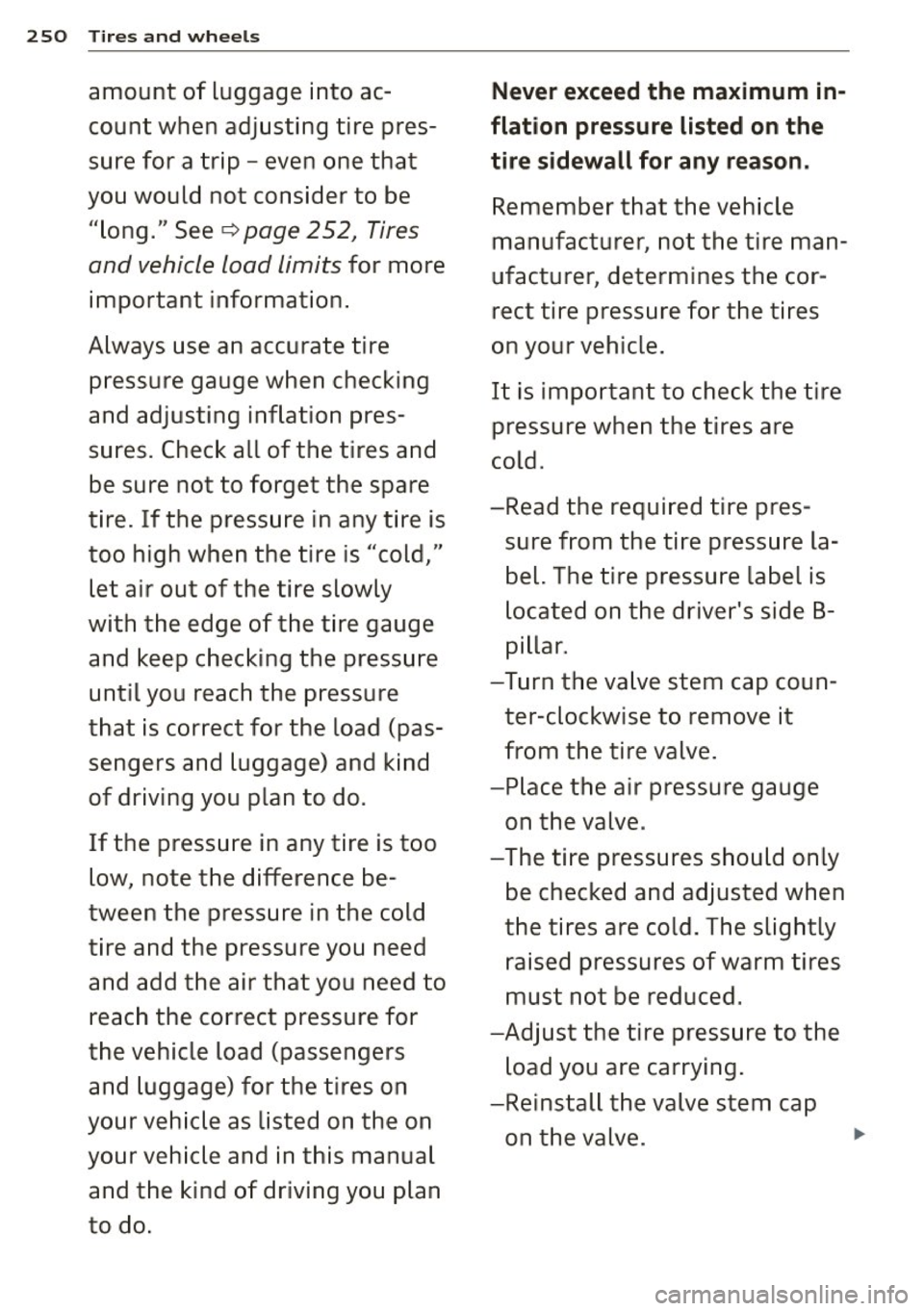
250 Tires and wheels
amount of luggage into ac-Never exceed the maximum in-
count when adjusting tire pres-flation pressure listed on the
sure for a trip -even one that tire sidewall for any reason.
you would not consider to be
Remember that the vehicle
"long." See
q page 2 52, Tires manufacturer, not the tire man-
and vehicle load limits for more ufacturer, determines the car-
important information. rect tire pressure for the tires
Always use an accurate tire on your vehicle.
pressure gauge when checking It is important to check the tire
and adjusting inflation pres- pressure when the tires are
sures. Check all of the tires and cold.
be sure not to forget the spare -Read the required tire pres-
tire. If the pressure in any tire is
sure from the tire pressure la-
too high when the tire is "cold,"
bel. The tire pressure label is
let air out of the tire slowly
located on the driver's side B-
with the edge of the tire gauge
pillar.
and keep checking the pressure
-Turn the valve stem cap coun-
until you reach the pressure
ter-clockwise to remove it
that is correct for the load (pas-
from the tire valve.
sengers and luggage) and kind
-Place the air pressure gauge
of driving you plan to do .
on the valve.
If the pressure in any tire is too -The tire pressures should only
low, note the difference be-
be checked and adjusted when
tween the pressure in the cold the tires are cold. The slightly
tire and the pressure you need
raised pressures of warm tires
and add the air that you need to must not be reduced.
reach the correct pressure for -Adjust the tire pressure to the
the vehicle load (passengers load you are carrying.
and luggage) for the tires on
-Reinstall the valve stem cap
your vehicle as listed on the on on the valve.
...
your vehicle and in this manual
and the kind of driving you plan
to do.
Page 253 of 314
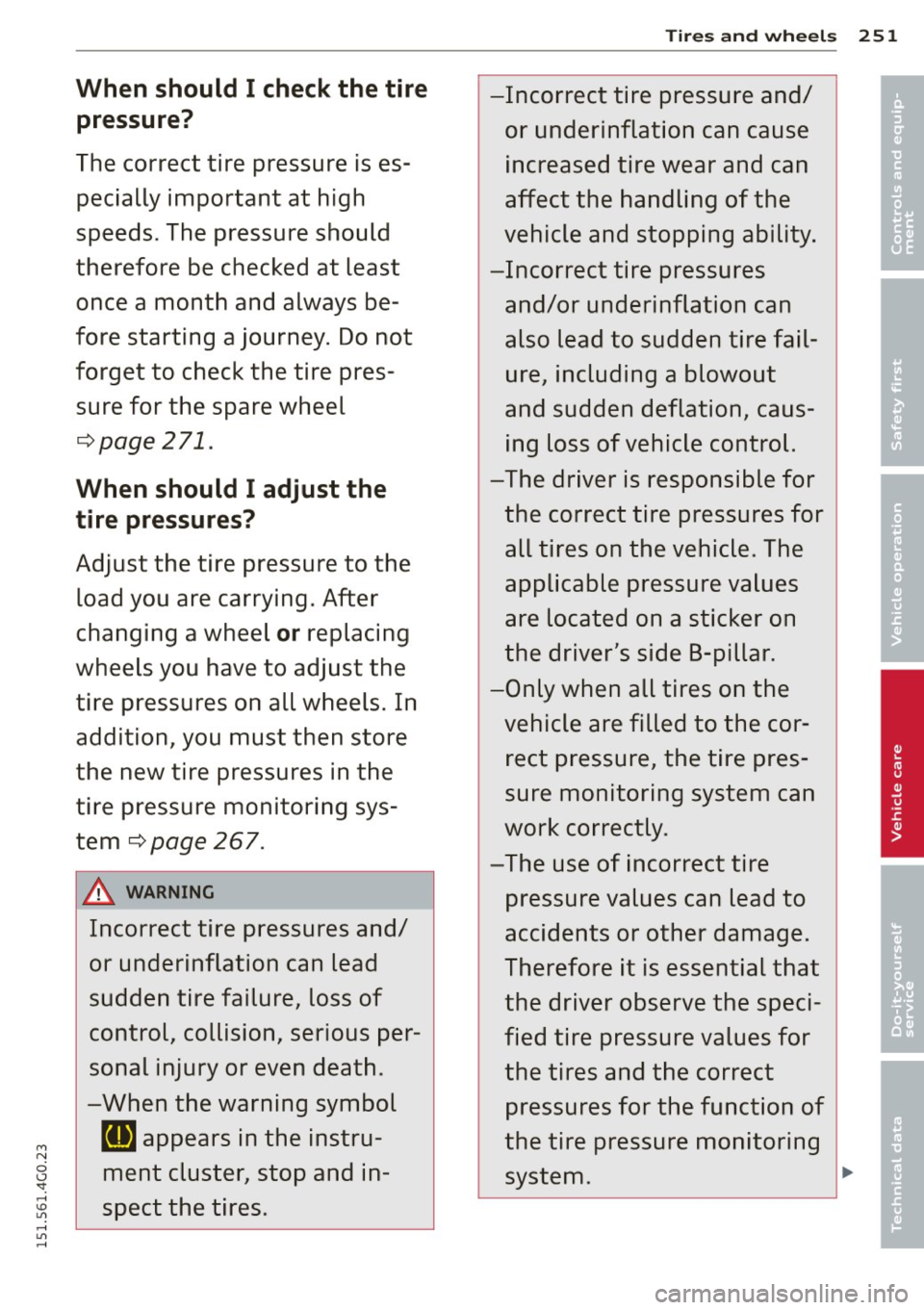
Tires and wheels 251
When should I check the tire -Incorrect tire pressure and/ •
pressure? or underinflation can cause • '
The correct tire pressure is es-increased tire wear and can
pecially important at high affect the handling of the
speeds . The pressure should
vehicle and stopping ability.
therefore be checked at least -Incorrect tire pressures
once a month and always be- and/or underinflation can
fore starting a journey. Do not also lead to sudden tire fail-
forget to check the tire pres- ure, including a blowout
sure for the spare wheel and sudden deflation, caus-
¢page 271. ing loss of vehicle control.
-The driver is responsible for
When should I adjust the
the correct tire pressures for ti re pressures?
Adjust the tire pressure to the all tires on the vehicle. The
applicable pressure values
load you are carrying. After
are located on a sticker on
changing a wheel
or replacing
the driver's side B -pillar.
wheels you have to adjust the
-Only when all tires on the
tire pressures on all wheels. In
vehicle are filled to the cor-
addition, you must then store
rect pressure, the tire pres-
the new tire pressures in the
sure monitoring system can
tire pressure monitoring sys-
work correctly.
tern
¢ page 267.
-The use of incorrect tire
.&, WARNING pressure values can lead to
Incorrect tire pressures and/ accidents or other damage.
or underinflation can lead Therefore it is essential that
sudden tire failure, loss of the driver observe the speci-
control, collision, serious per- fied tire pressure values for
sonal injury or even death. the tires and the correct
-When the warning symbol pressures for the function of
M (IJ appears in the instru-the tire pressure monitoring
N
0 ment cluster, stop and in- system. .,. <.J 'SI: ,....,
spect the tires. \!) 1.1'1 ,...., 1.1'1 ,....,
Page 254 of 314
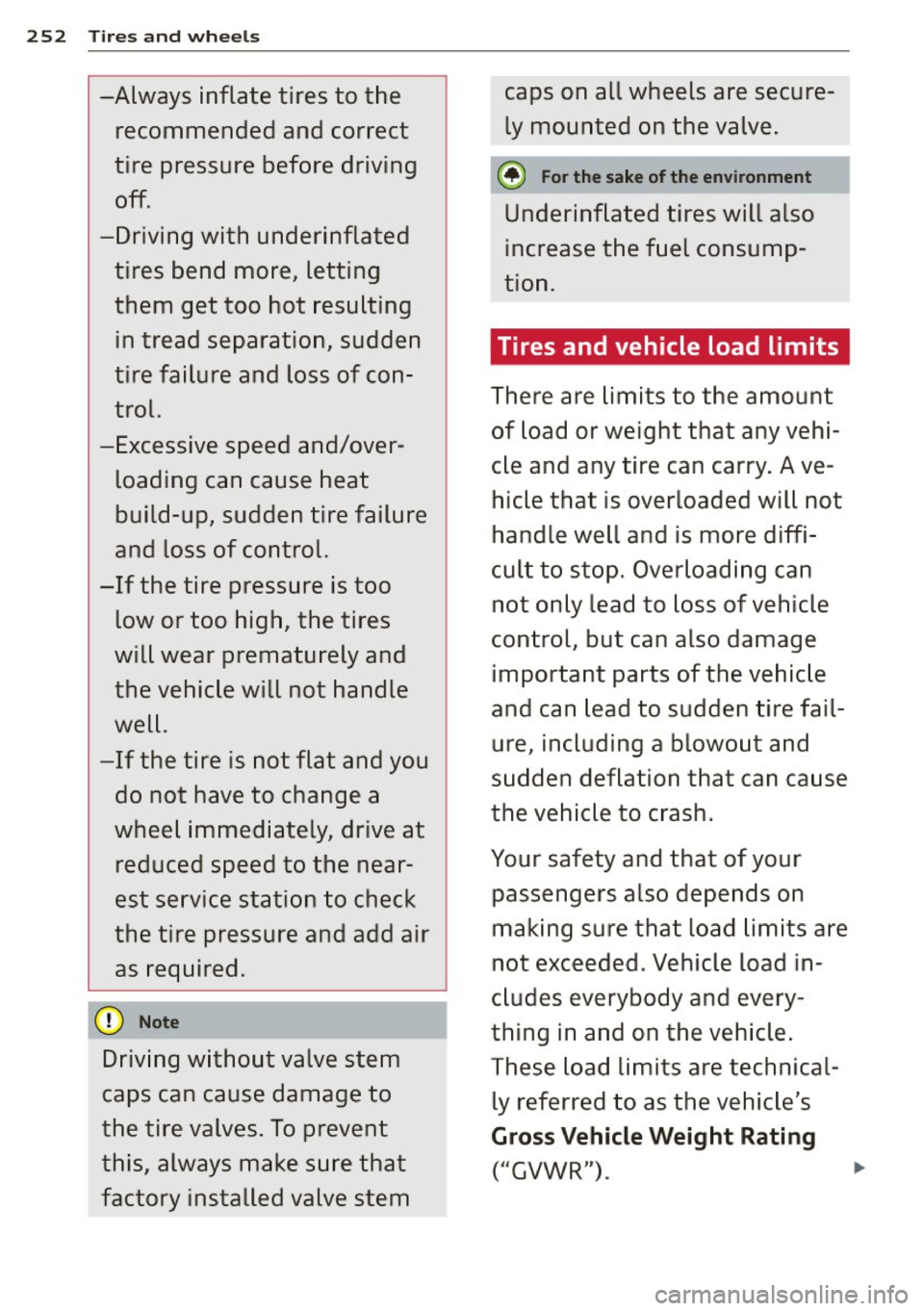
252 Tires and wheels
-Always inflate tires to the
recommended and correct
tire pressure before driving
off .
-Driving with underinflated tires bend more, letting
them get too hot resulting
in tread separation, sudden
tire failure and loss of con
trol.
-Excessive speed and/over loading can cause heat
build-up, sudden tire failure
and loss of control.
-If the tire pressure is too low or too high, the tires
will wear prematurely and the vehicle will not handle
well.
- If the tire is not flat and you
do not have to change a
wheel immediately, drive at
reduced speed to the near
est service station to check
the tire pressure and add air
as required.
@ Note
Driving without valve stem
caps can cause damage to
the tire valves. To prevent
this, always make sure that
factory installed valve stem caps on all
wheels are secure
ly mounted on the valve.
@) For the sake of the environment
Underinflated tires will also
increase the fuel consump
tion.
Tires and vehicle load limits
There are limits to the amount of load or weight that any vehi
cle and any tire can carry. Ave
hicle that is overloaded will not
handle well and is more diffi
cult to stop. Overloading can not only lead to loss of vehicle
control, but can also damage
important parts of the vehicle
and can lead to sudden tire fail
ure, including a blowout and
sudden deflation that can cause
the vehicle to crash.
Your safety and that of your
passengers also depends on
making sure that load limits are
not exceeded. Vehicle load in
cludes everybody and every
thing in and on the vehicle.
These load limits are technical
ly referred to as the vehicle's
Gross Vehicle Weight Rating
("GVWR "). .,..
Page 255 of 314
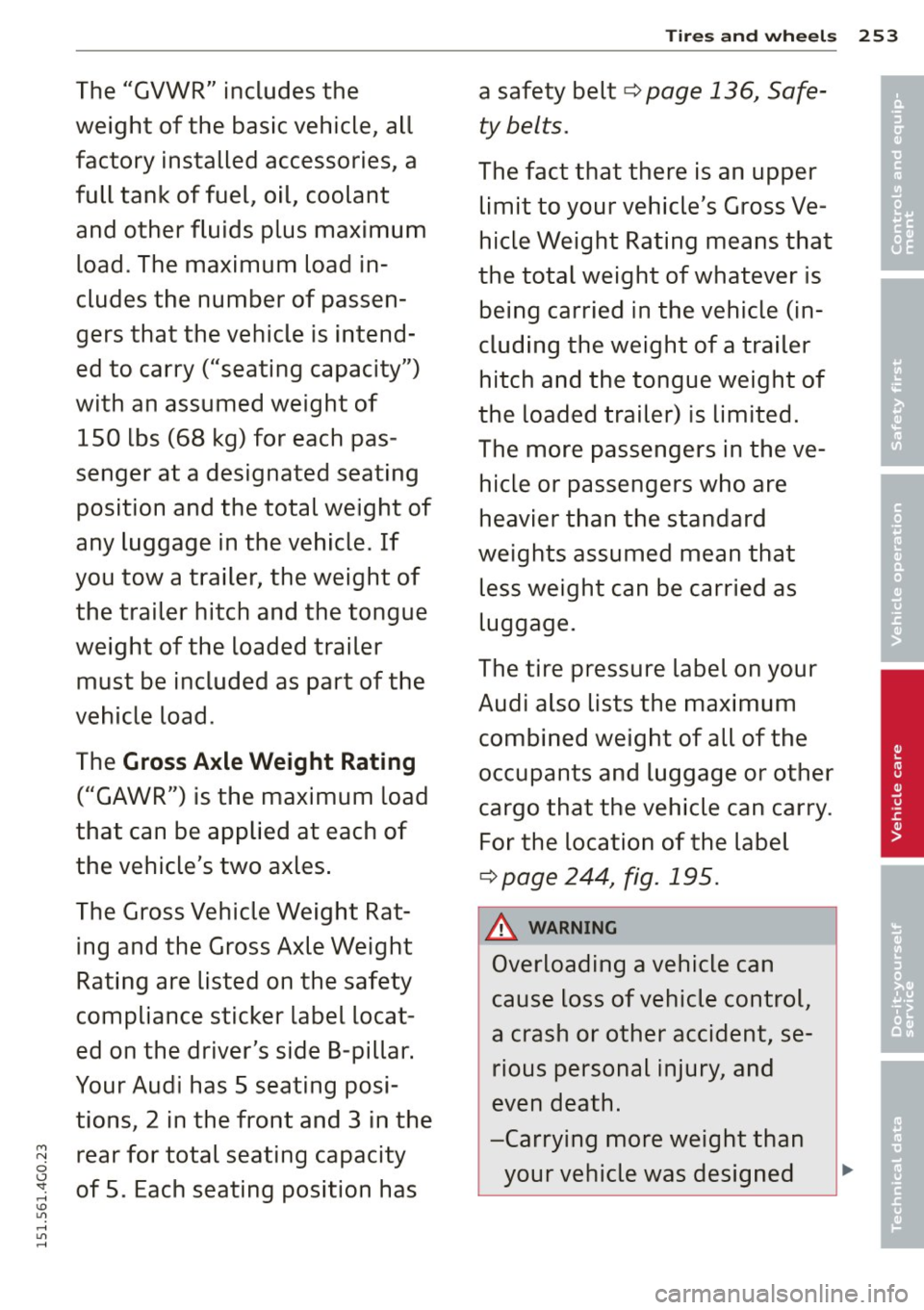
M N
0 <.J 'SI: ,...., \!) 1.1'1 ,...., 1.1'1 ,....,
The "GVWR" includes the
weight of the basic vehicle, all
factory installed accessories, a
full tank of fuel, oil, coolant and other fluids plus maximum
load. The maximum load in
cludes the number of passen
gers that the vehicle is intend
ed to carry ("seating capacity")
with an assumed weight of 150 lbs (68 kg) for each pas
senger at a designated seating
position and the total weight of
any luggage in the vehicle. If
you tow a trailer, the weight of the trailer hitch and the tongue
weight of the loaded trailer
must be included as part of the
vehicle load.
The
Gross Axle Weight Rating
("GAWR") is the maximum load
that can be applied at each of
the vehicle's two axles.
The Gross Vehicle Weight Rat ing and the Gross Axle Weight Rating are listed on the safety
compliance sticker label locat
ed on the driver's side B-pillar.
Your Audi has 5 seating posi
tions, 2 in the front and 3 in the rear for total seating capacity
of 5. Each seating position has
Tires and wheels 253
a safety belt¢ page 136, Safe
ty belts.
The fact that there is an upper
limit to your vehicle's Gross Ve
hicle Weight Rating means that
the total weight of whatever is being carried in the vehicle (in
cluding the weight of a trailer
hitch and the tongue weight of
the loaded trailer) is limited.
The more passengers in the ve
hicle or passengers who are
heavier than the standard
weights assumed mean that less weight can be carried as
luggage.
The tire pressure label on your
Audi also lists the maximum combined weight of all of the
occupants and luggage or other
cargo that the vehicle can carry.
For the location of the label
¢ page 244, fig. 195.
A WARNING
-
Overloading a vehicle can
cause loss of vehicle control,
a crash or other accident, se
rious personal injury, and
even death.
-Carrying more weight than your vehicle was designed
•
•
'
'
• •
Page 256 of 314
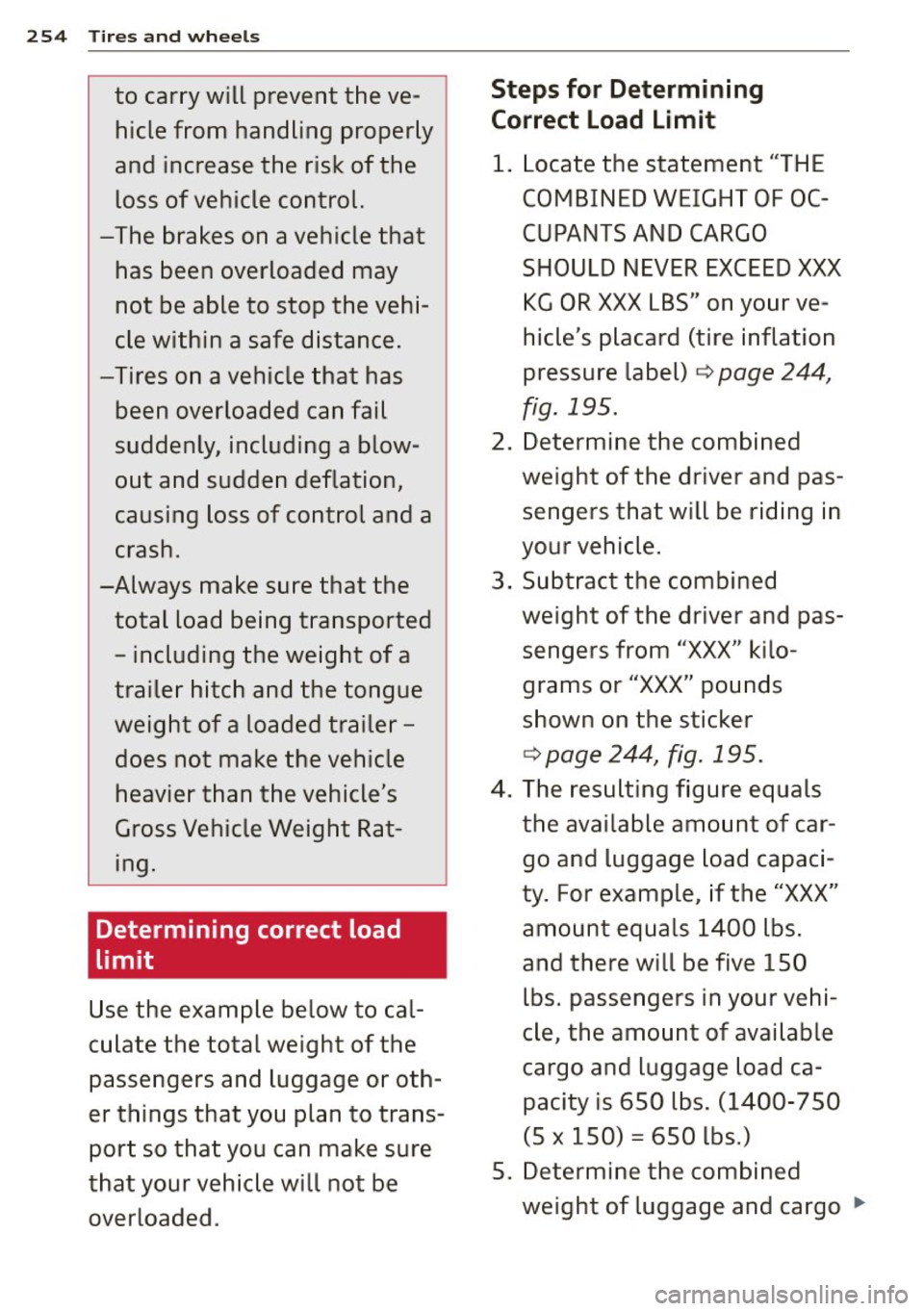
254 Tires and wheels
to carry will prevent the ve
hicle from handling properly
and increase the risk of the loss of vehicle control.
-The brakes on a vehicle that has been overloaded may
not be able to stop the vehi
cle within a safe distance.
-Tires on a vehicle that has
been overloaded can fail
suddenly, including a blow
out and sudden deflation,
causing loss of control and a
crash.
-Always make sure that the total load being transported
- including the weight of a
trailer hitch and the tongue
weight of a loaded trailer -
does not make the vehicle heavier than the vehicle's
Gross Vehicle Weight Rat
ing.
Determining correct load
limit
Use the example below to cal
culate the total weight of the
passengers and luggage or oth
er things that you plan to trans
port so that you can make sure
that your vehicle will not be overloaded.
Steps for Determining Correct Load Limit
1. Locate the statement "THE
COMBINED WEIGHT OF OC
CUPANTS AND CARGO
SHOULD NEVER EXCEED XXX KG OR XXX LBS" on your ve
hicle's placard (tire inflation
pressure label)
~ page 244,
fig. 195.
2. Determine the combined weight of the driver and pas
sengers that will be riding in
your vehicle.
3. Subtract the combined weight of the driver and pas
sengers from
"XXX" kilo
grams or
"XXX" pounds
shown on the sticker
~ page 244, fig. 195.
4. The resulting figure equals
the available amount of car
go and luggage load capaci
ty. For example, if the
"XXX"
amount equals 1400 lbs.
and there will be five 150 lbs. passengers in your vehi
cle, the amount of available
cargo and luggage load ca
pacity is 650 lbs. (1400-750
(5
X 150) = 650 lbs.)
5. Determine the combined weight of luggage and cargo .,..
Page 257 of 314
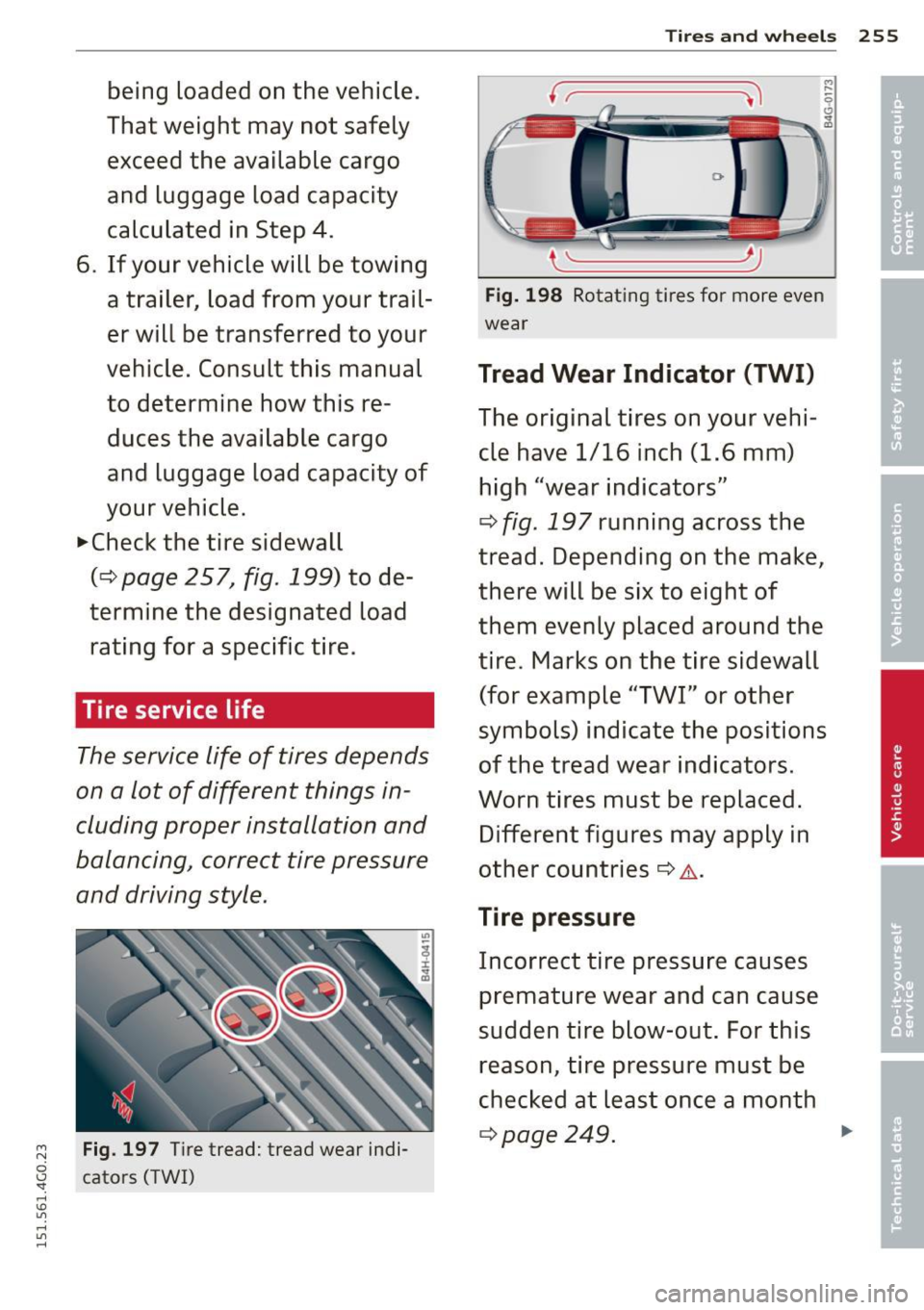
M N
0 I.J ""'. rl I.O
"' rl
"' rl
being loaded on the vehicle.
That weight may not safely
exceed the available cargo
and luggage load capacity
calculated in Step 4.
6. If your vehicle will be towing
a trailer, load from your trail
er will be transferred to your
vehicle. Consult this manual
to determine how this re
duces the available cargo
and luggage load capacity of
your vehicle.
.,.Che ck the tire sidewall
(¢ page 257, fig. 199) to de
termine the designated load rating for a specific tire.
Tire service life
The service life of tires depends
on a lot of different things in
cluding proper installation and
balancing, correct tire pressure and driving style.
Fig . 197 Tire tread: tread wear indi
cators (TWI)
Tires and wheels 255
Fig. 198 Rotating tires for more even
wear
Tread Wear Indicator (TWI)
The original tires on your vehi
cle have
1/16 inch (1.6 mm)
high "wear indicators"
¢ fig. 197 running across the
tread. Depending on the make,
there will be six to eight of
them evenly placed around the
tire. Marks on the tire sidewall (for example "TWI" or other
symbols) indicate the positions
of the tread wear indicators.
Worn tires must be replaced.
Different figures may apply in
other countries
¢ & .
Tire pressure
Incorrect tire pressure causes
premature wear and can cause
sudden tire blow-out. For this
reason, tire pressure must be
checked at least once a month
¢ page 249.
Page 258 of 314
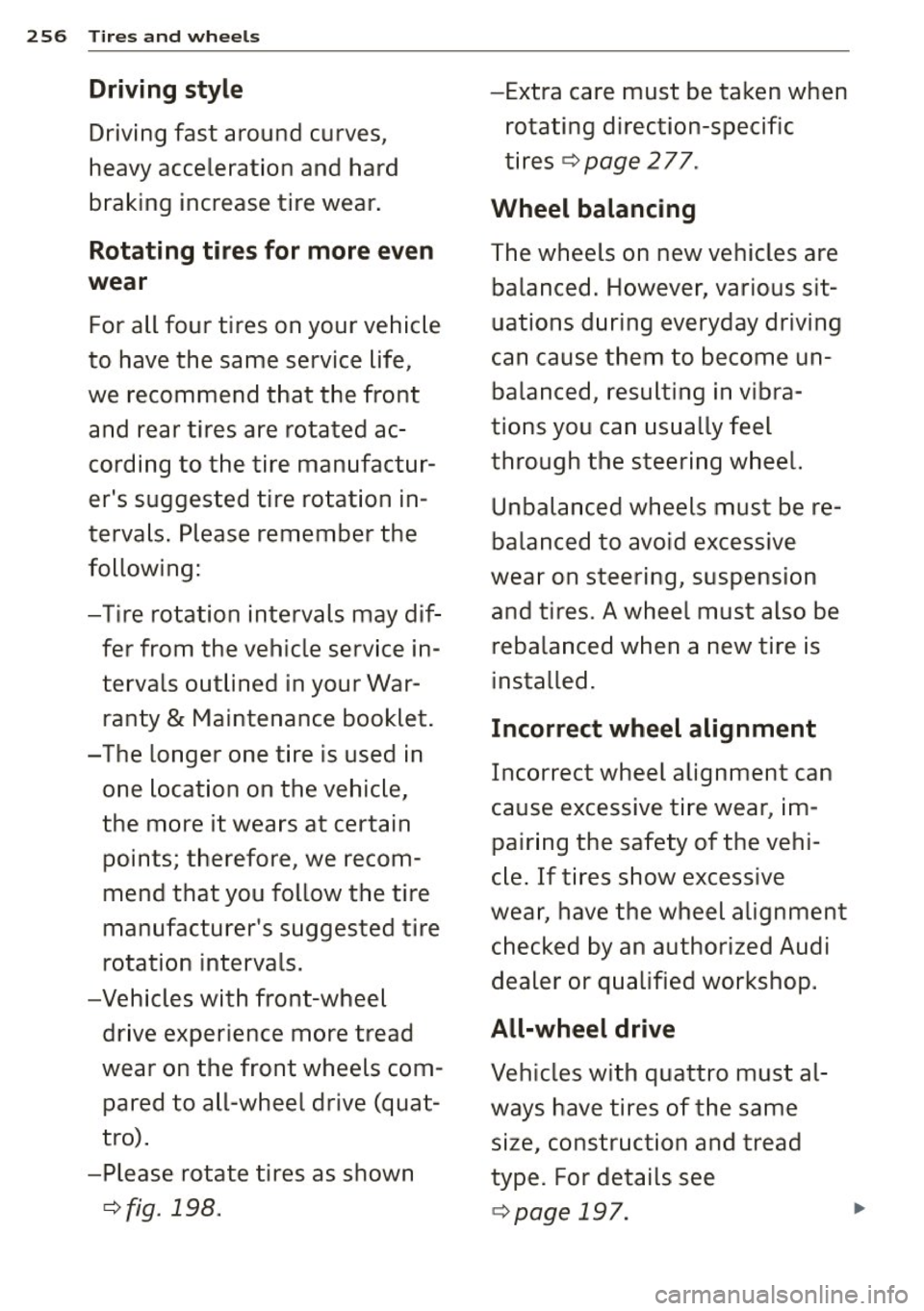
256 Tires a nd whee ls
Driving style - Extra care must be ta ken when
Driving fast around curves , rotat
ing direction-specific
heavy acceleration and hard tires
¢
page 2 77.
b raking increase tire wear.
Wheel balancing
Rotating tires for more even
The wheels on new vehicles are
wear ba lanced. However, various sit-
For all four tires on your vehicle uations during everyday driving
to have the same service life, can cause them to become un-
we recommend that the front balanced, resulting in vibra-
and rear tires are rotated ac -tions you can usually feel
cording to the tire manufactur- through the steering wheel.
er's suggested tire rotation in- Unbalanced wheels must be re-
tervals . Please remember the
balanced to avoid excessive
following: wear on steering, suspension
-T ire rotation intervals may dif -and tires. A wheel must also be
fer from the vehicle service in· rebalanced when a new tire is
tervals outlined in your War- insta
lled.
ranty
& Maintenance booklet . Incorrect wheel alignment
-The longer one tire is used in
Incorrect wheel alignment can
one location on the vehicle,
cause excessive tire wear, im-
the more it wears at certain
pairing the safety of the vehi-
points; therefore, we recom-
cle. If tires show excessive
mend that you follow the tire
wear, have the wheel alignment
manufacturer's suggested tire
checked by an authorized Audi
rotation intervals.
dealer or qualified workshop.
-Vehicles with front-wheel
dr ive experience more t read
All-wheel drive
wear on the front wheels com-
Vehicles with quattro must al-
pared to all-wheel drive (quat- ways have tires of the same
tro) .
size, construction and tread
-Please rotate tires as shown type. For details see
¢
fig . 198. ¢page 197. ...
Page 259 of 314
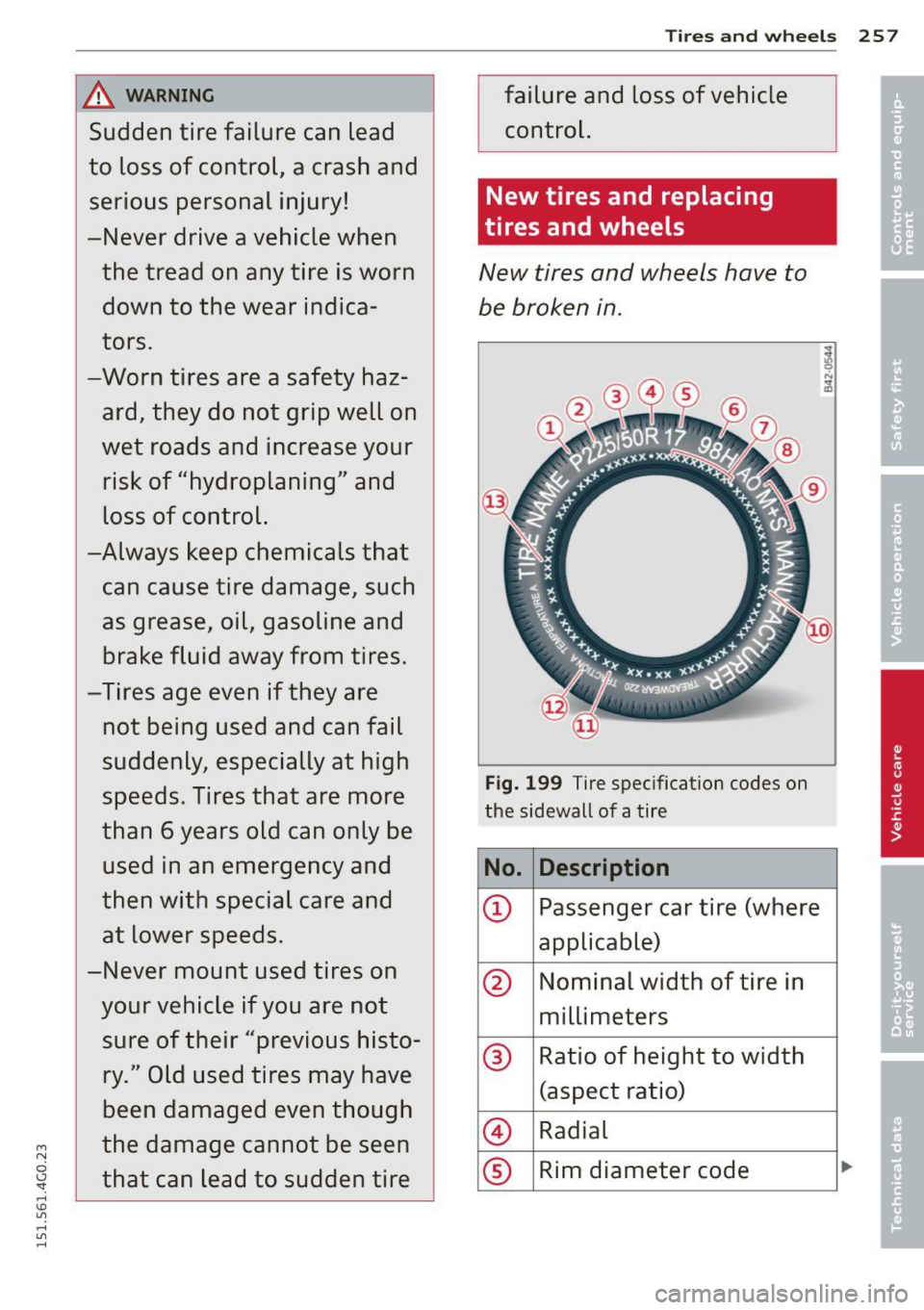
M N
0 I.J "". rl I.O
"' rl
"' rl
_&. WARNING
Sudden tire failure can lead
to loss of control, a crash and serious personal injury!
-Never drive a vehicle when the tread on any tire is worn down to the wear indica
tors.
-
-Worn tires are a safety haz ard, they do not grip well on
wet roads and increase your risk of "hydroplaning" and
loss of control.
-Always keep chemicals that can cause tire damage, such
as grease, oil, gasoline and brake fluid away from tires .
-Tires age even if they are not being used and can fail
suddenly, especially at high
speeds. Tires that are more
than 6 years old can only be used in an emergency and
then with special care and at lower speeds.
-Never mount used tires on your vehicle if you are not sure of their "previous history." Old used tires may have
been damaged even though
the damage cannot be seen
that can lead to sudden tire
Tires and wheels 257
failure and loss of vehicle control.
New tires and replacing
tires and wheels
New tires and wheels hove to
be broken in.
Fig. 199 Tire specification codes on
the sidewall of a tire
No. Description
CD Passenger car tire (where
applicable)
0 Nominal width of tire in
millimeters
® Ratio of height to width
(aspect ratio)
© Radial
® Rim diameter code
Page 260 of 314
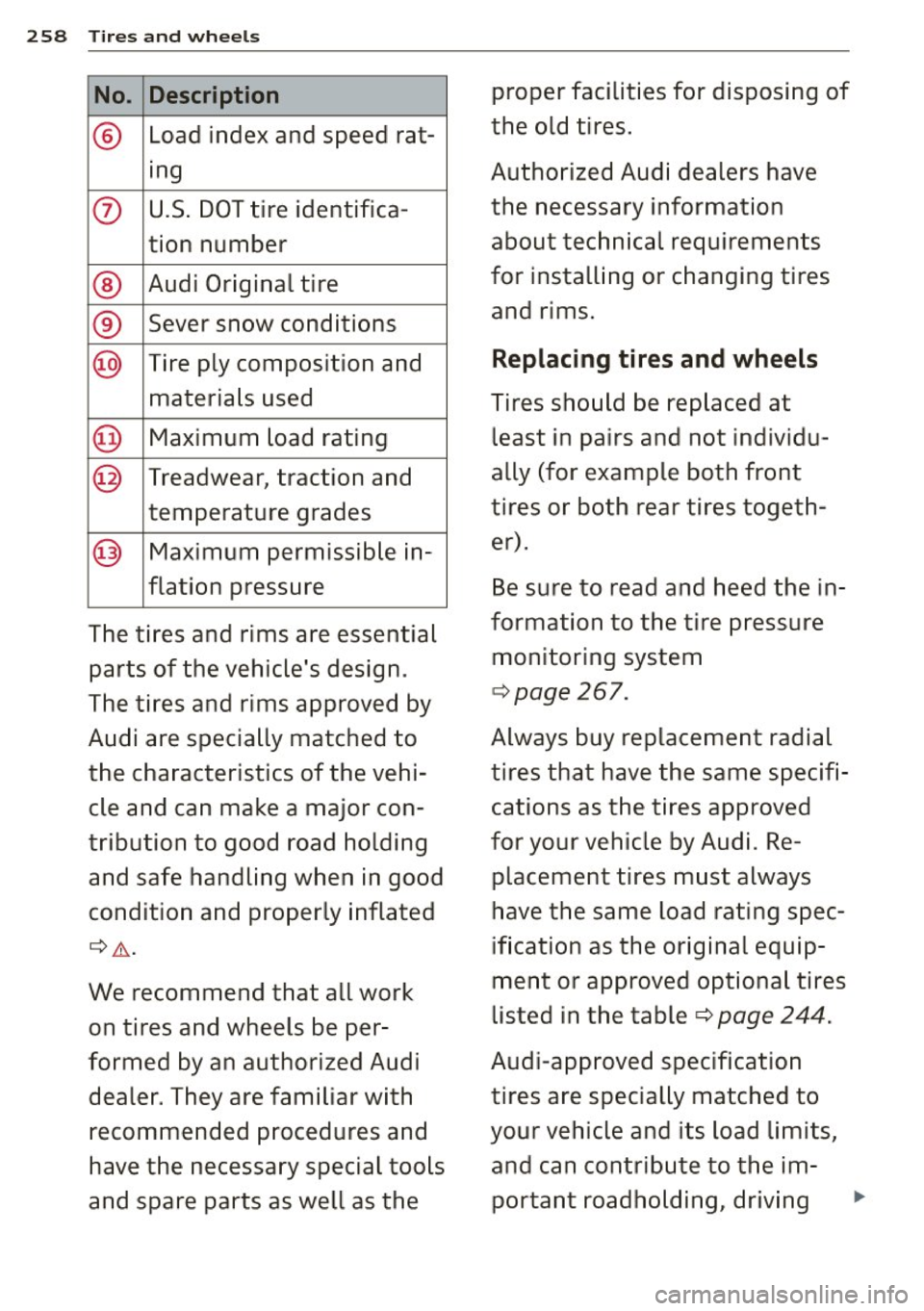
258 Tires an d whee ls
No . Description
® Load index and speed rat-
ing
(J) U.S . DOT tire identifica-
tion number
® Audi Original tire
® Sever snow conditions
@ Tire ply composition and materials used
@ Maximum load rating
@ Treadwear, traction and
temperature grades
@ Maximum permissible in-
flation pressure
T he tires and rims are essential
parts of the vehicle's design .
The tires and rims approved by
Audi are specially matched to
the characteristics of the vehi
cle and can make a major con
tribution to good road holding and safe handling when in good
condition and properly inflated
c::> ,&. .
We recommend that a ll work
on tires and wheels be per
formed by an authorized Audi
deale r. They are familiar with
r ecommended p rocedures and
have the necessary special too ls
and spare parts as well as the proper facilities for disposing of
the old ti res.
Autho rized Audi dealers have
the necessary information
about technical requirements
for installing or changing tires
and rims .
Replacing tires and wheels
Tires sho uld be replaced at
least in pairs and not individu
ally (for example both front
tires or both rear tires togeth
er).
B e sure to read and heed the in
formation to the tire pressure
monitoring system
c::> page 267.
Always buy replacement radial
tires that have the same specifi
cations as the tires approved
f or your vehicle by Audi. Re
placeme nt tires m ust always
have the same load rating spec
ification as the orig inal equip
ment or approved optional tires
listed in the table
c::> page 244.
Audi-app roved spec ificat io n
tires are specially matched to
your vehicle and its load limits ,
and can contribute to the im -
portant roadholding, driv ing .,.